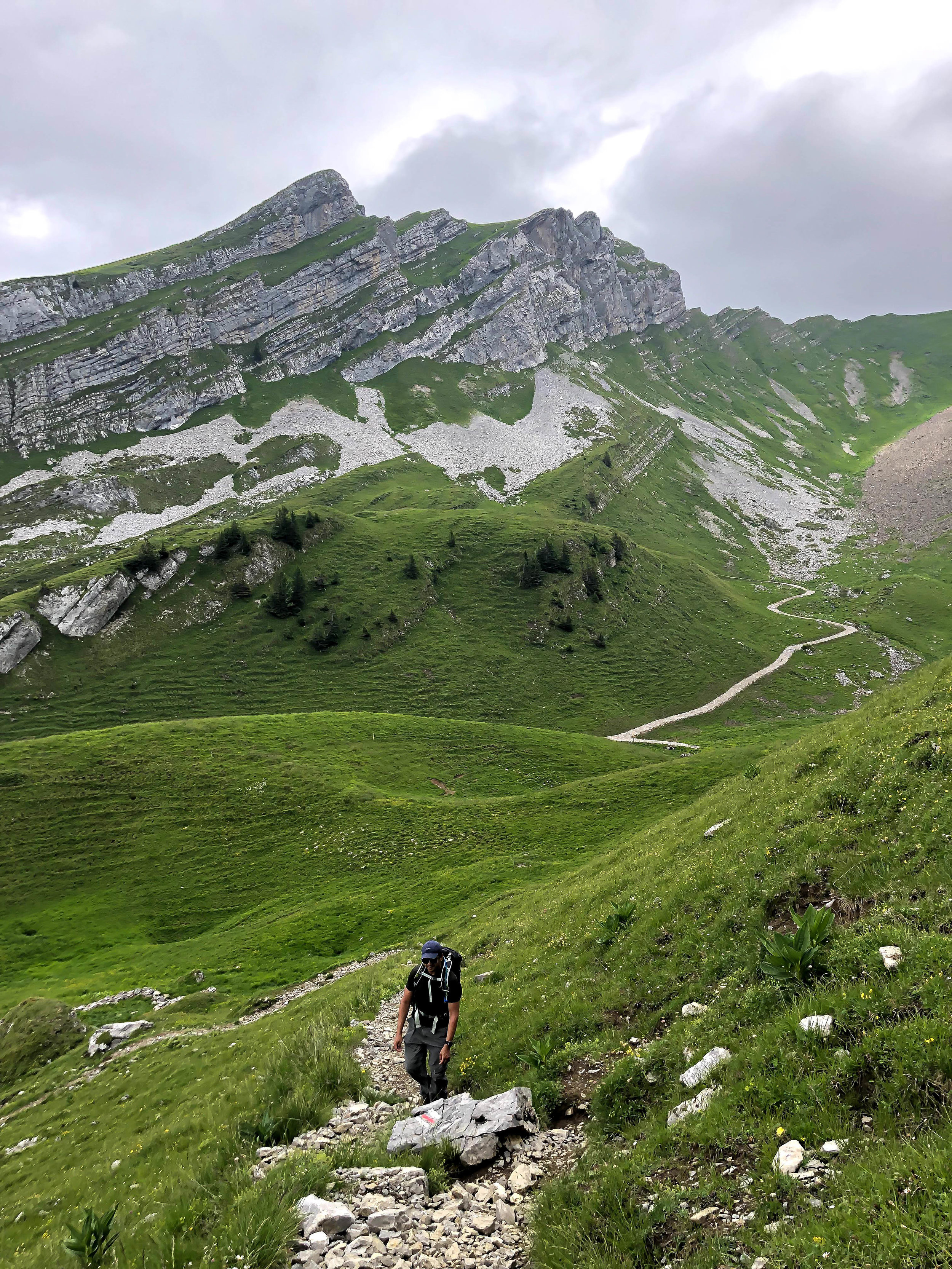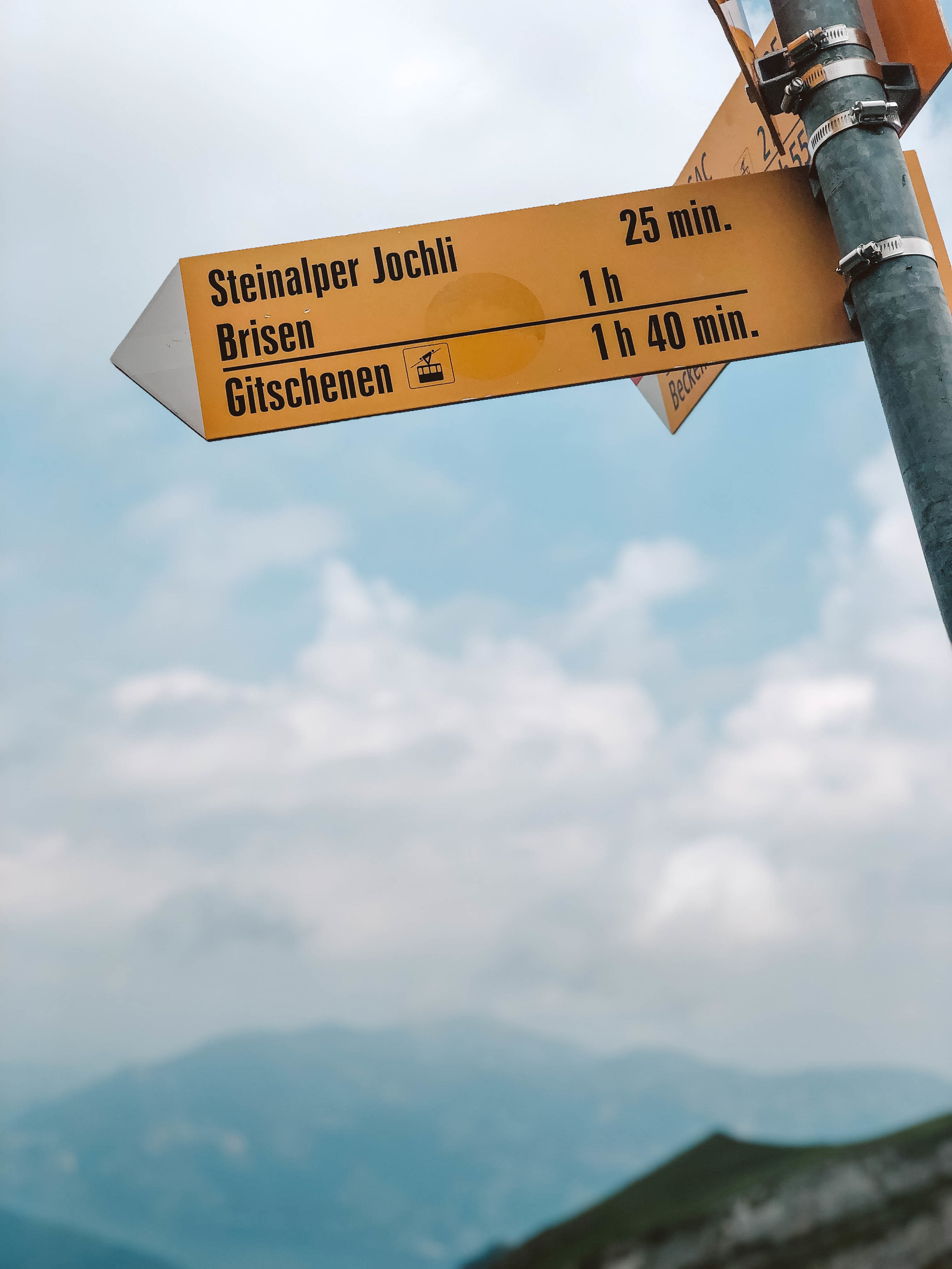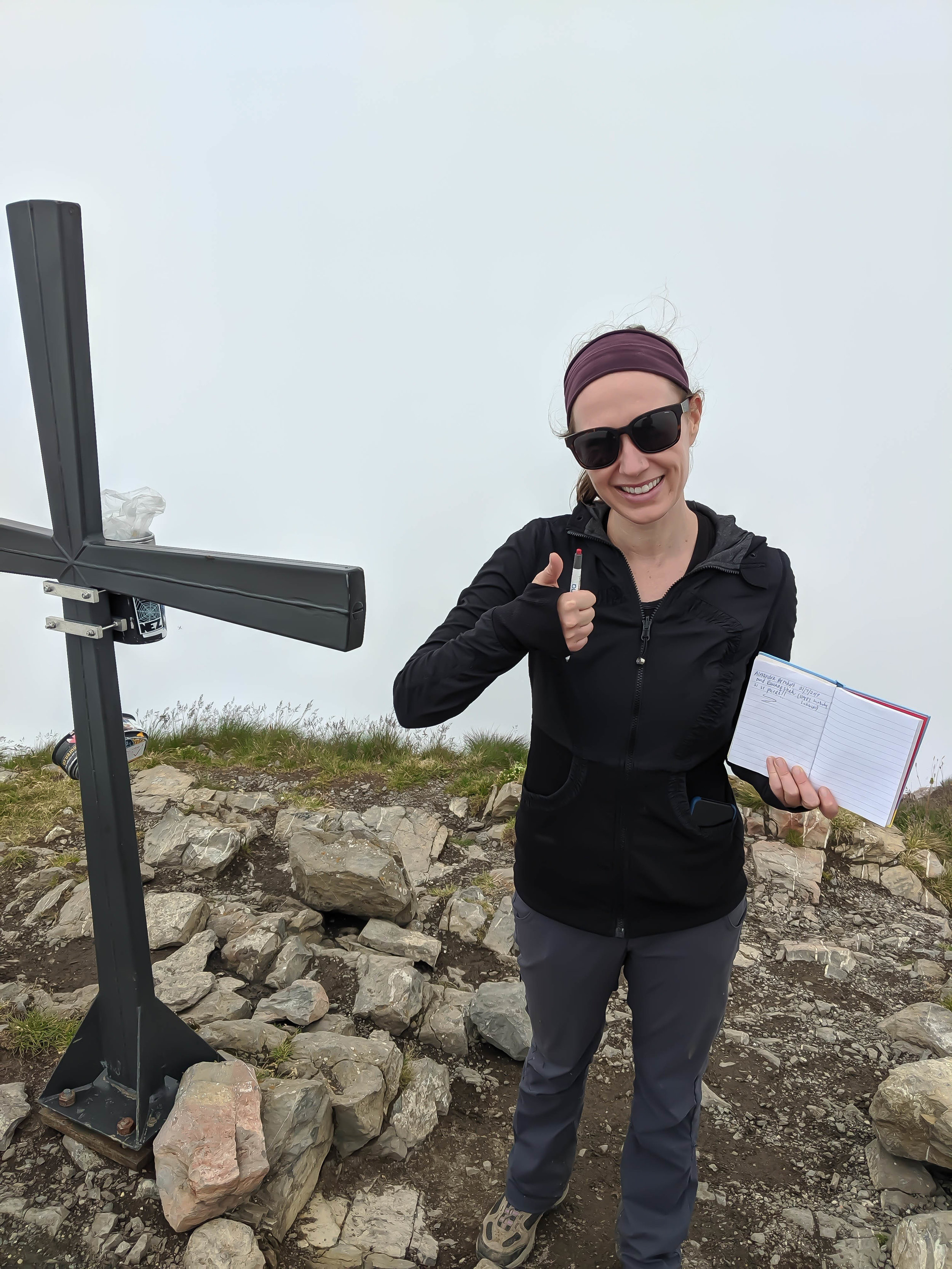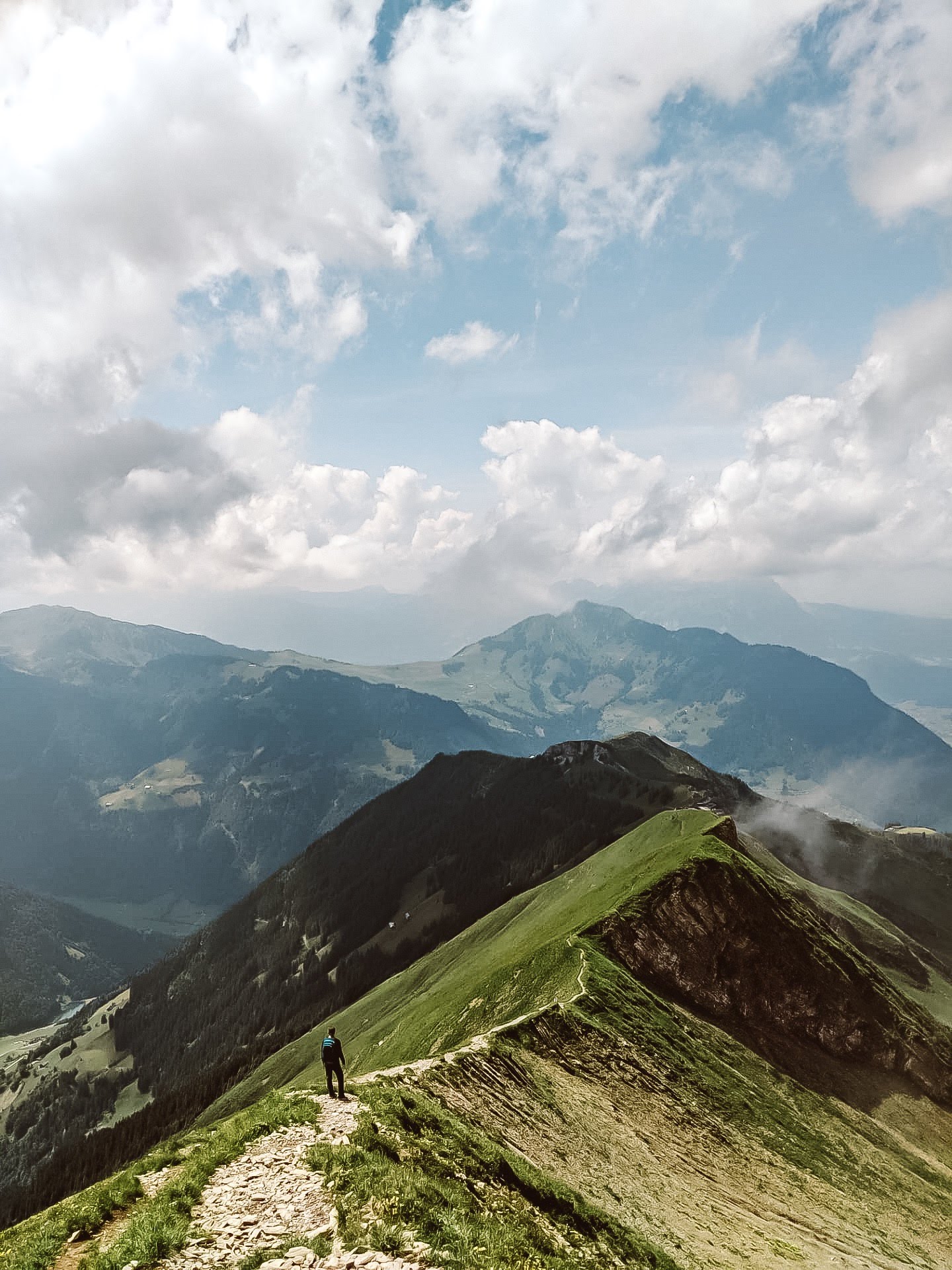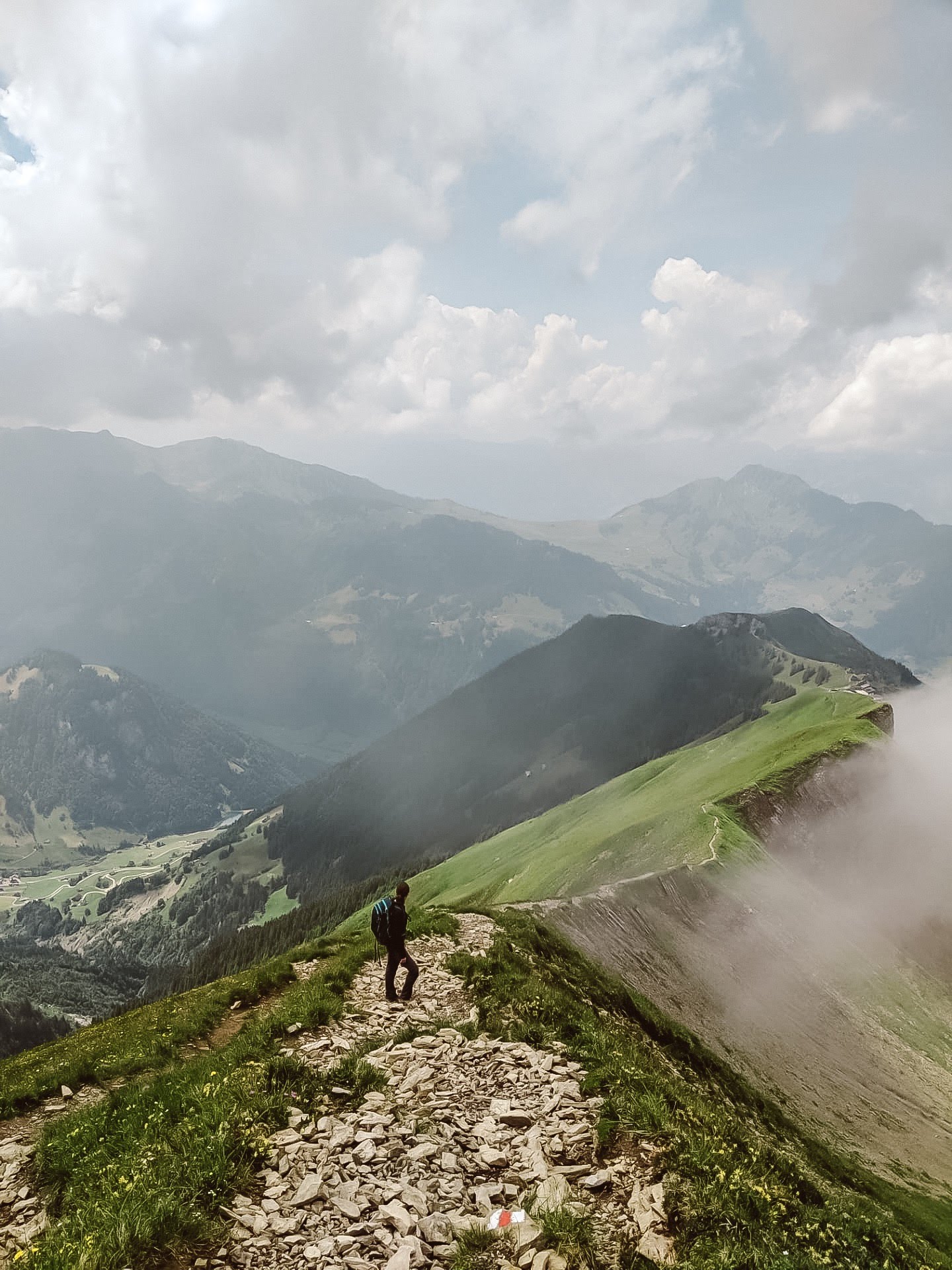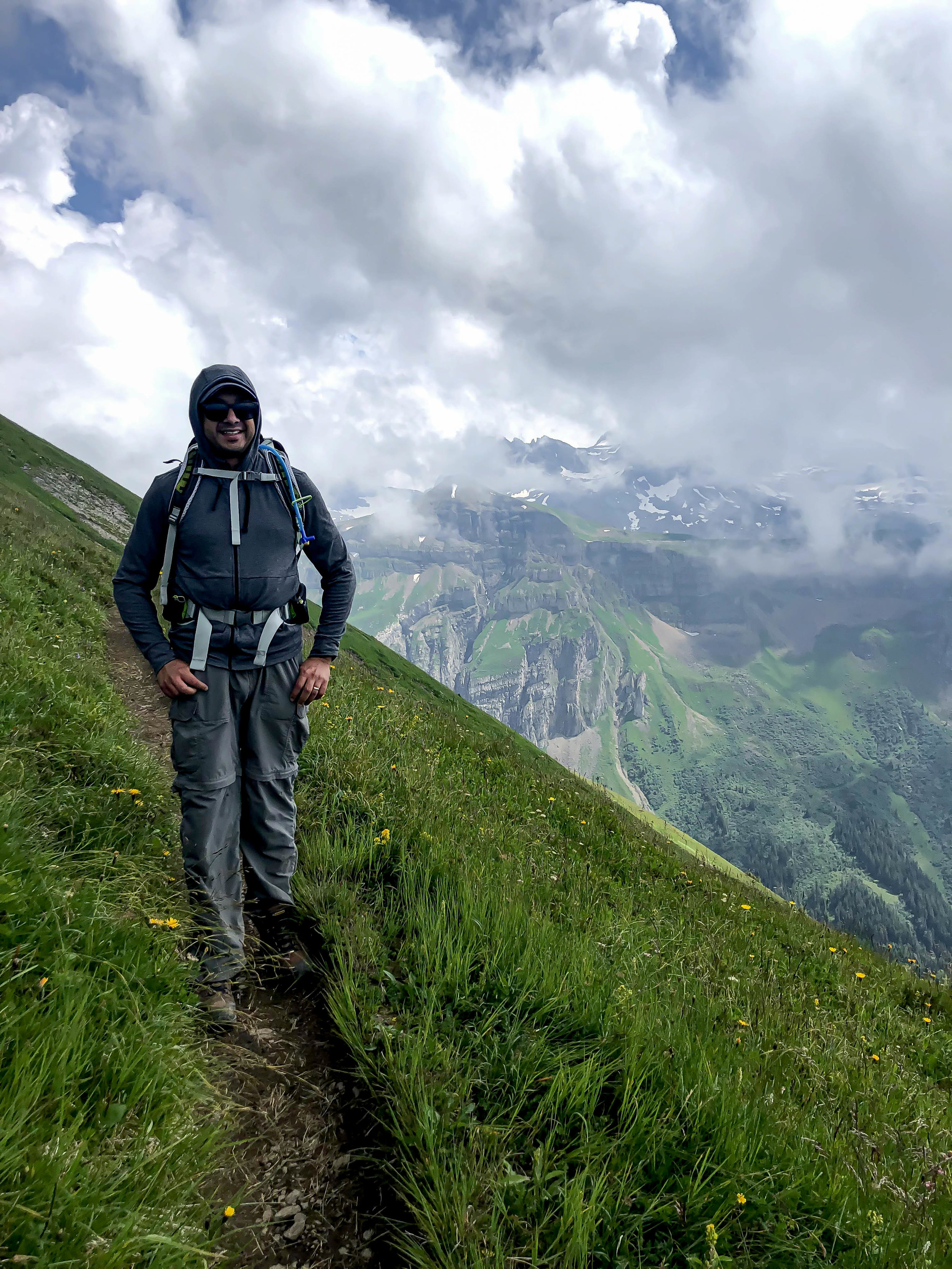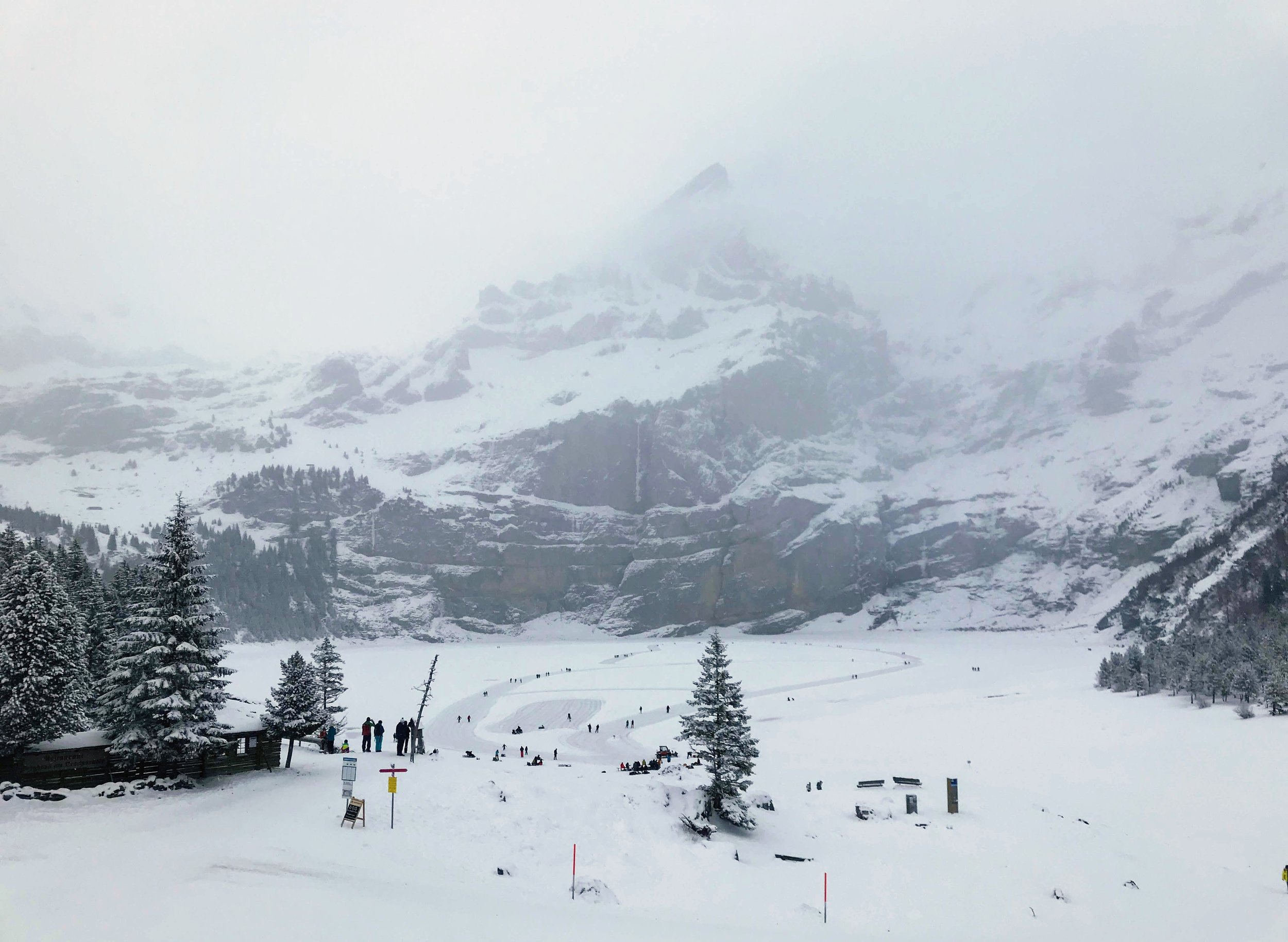If Your Nerve Deny You: Brisen Peak and Haldigrat Ridge
If your nerve deny you,
go above your nerve.
-Emily Dickinson
I generally don’t write in-depth posts about specific hikes that we do. Instead, I tend to include them in large round-ups: Favorite summer hikes of 2018, best spring hikes, and the like.
But every so often, there is a hike that is special (shh, don’t tell the other trails). And this one, the Brisen Peak and Haldigrat ridge, was special enough to merit its own blog post. There are a couple of reasons why. First, I had never even heard of this canton before, so the whole area felt a little bit undiscovered. Second, the whole experience felt “classically Swiss,” from start to finish. And third, this was a hike that challenged me in a new way. Physically demanding, yes. Tough, absolutely. But I wasn’t expecting it to be so mentally taxing.
Fine, the fourth reason: I wanted an excuse to post more pictures of this place.
We did this hike almost a month ago. If I’m being honest, when I look back on the day, I can see how much my nerves got the best of me, the way I crawled into my own head of anxieties, and how I made the fear bigger than it really was. It’s not that crazy of a hike. In fact, it’s fantastic and completely within my abilities. But I’m going to do the best I can to write in the spirit of the moment, and call back exactly how I was feeling in the thick of it. Because that day required more courage, confidence and (for me) nerves of steel than any other hike we’ve embarked on so far. And I had no idea this was coming for me on what seemed like an average Sunday trek.
So, let’s get into it.
Nidwalden, Maria-Rickenbach, and Niederrickenback
One of my favorite Swiss hiking bloggers (who we lovingly call MomsTots, even though she has since rebranded her website) recommended the Haldigrat ridge and Brisen peak hike, describing it as “tough, a bit scary, and worth it.” All of my favorite things. Sold! This trail is located in the Maria-Rickenbach area, close to Lucerne, in the canton of Nidwalden. I had never even heard of this region before. Even the name threw me off. Who, pray tell, is Maria? I got even more confused when I clicked on the link for the trail description, because it took me to this old-school, basic HTML looking website - not a fancy, flashy website with webcams and interactive hike filters that other mountains have. Intriguing. We figured out basic directions and decided to set out on the next sunny Sunday.
What makes this area more interesting is that it is tucked in between some of the most visited places in Switzerland - Mt. Titlis and Lucerne - but despite this proximity, also feels entirely off the beaten track. The town of Niederrickenback is on the popular Engelberg-Lucern train route, and most people on said train are tourists. It’s such a small little town that we needed to request the train stop for Niederrickenback (the train won’t stop there automatically). A couple fellow hikers and a cute elderly couple got off with us, while the rest of train-riding tourists were whisked away to Titlis. The Niederrickenback Luftseilbahnen is located right next to the train stop, and we queued up to board the short aerial cablecar to the village.
Raunaq and I spent some time hemming and hawing once we got to the top. Neither of us had gotten a great night’s sleep, we had woken up early, and it was a little rainy (though with a variable promise of sunshine). We couldn’t decide if we wanted to skip the Brisen peak part, and just do the Haligrat ridge - or fully commit to the whole 5 hour hike. I think we were both feeling a bit tired, but also, didn’t want to miss out on an adventure. If one of us had given an inch, I’m sure the other would had taken it. But FOMO struck again, and with neither of us willing to give up before we started, we agreed to hike the whole thing: Niederrickenbach to Brisen Peak, then down the Haldigrat ridge.
But first, let’s talk about the Niederrickenbach village, a tiny town in the Engelberergtal valley. Because it is the most quintessentially Swiss spot in all the land. The heart of central Switzerland in every sense of the word. It has a Benedictine monastery, a little church with a steeple, a cozy inn that serves Musenalp cheese and fresh alpine milk from the 50 cows that wander the mountain, a handful of painfully quaint half-timbered homes, and not much else. Apparently, it’s also a popular pilgrimage spot and is known to be a sacred source of energy. It’s easy to see why. The entire village was serenely beautiful.
Now, I’m proud to say that after a year in this country, I have learned how to rein in the urge to belt out songs from the Sound of Music while on a Swiss mountain. It was finally under control. But if there was any place that I was going to slip into a relapse, it’s in Niederrickenback village. I mean, this place has a convent and is named after a Maria, for crying out loud. It’s just asking for a hearty rendition of “The Hills are Alive.” Days gone without singing: back to zero.
But even with all this classic Swissness, Raunaq kept calling it Maria Quesadilla mountain, and sadly, it stuck. Sorry, Maria.
Part 1 - Ignorance is bliss
Niederrickenbach - Brändlisboden - Brisenhaus
The trail started out innocently enough. Once we left the village, the path wove us through a small forest before starting a gradual but steady incline. It’s worth noting here at the beginning of the story that we were doing this hike “backward.” MomsTots had taken a lift all the way up to Haligrat to tackle the ridge section first. She warned that this hike had a long, tough descent from Brisen peak: about 1200 steep meters, with lots of loose rocks and boulders. I could feel my knees aching as I read those words, so Raunaq and I reversed the direction of the hike, opting to start with a 1200 meter ascent, summiting Brisen peak, and then ending with the Haldigrat ridge.
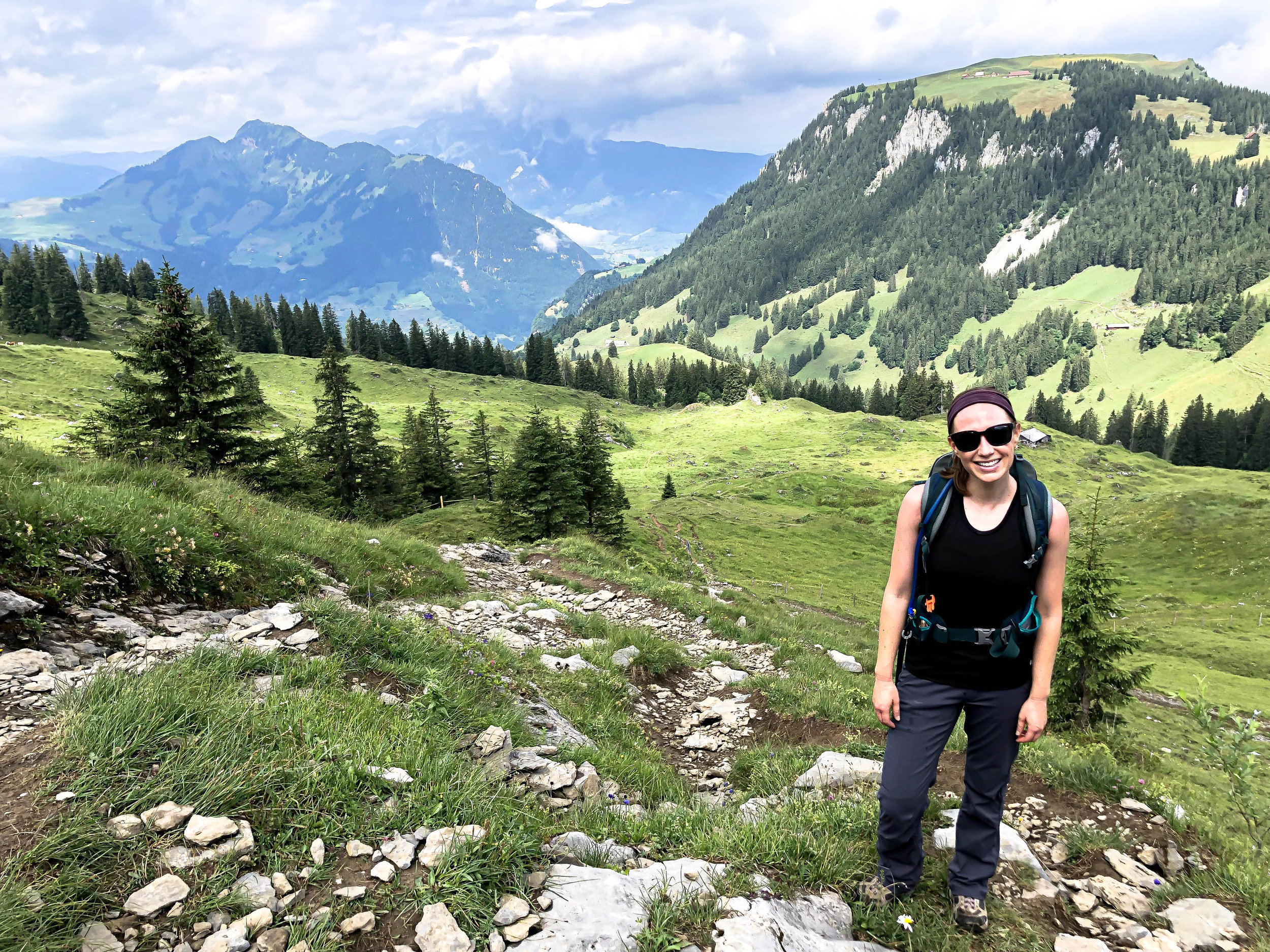
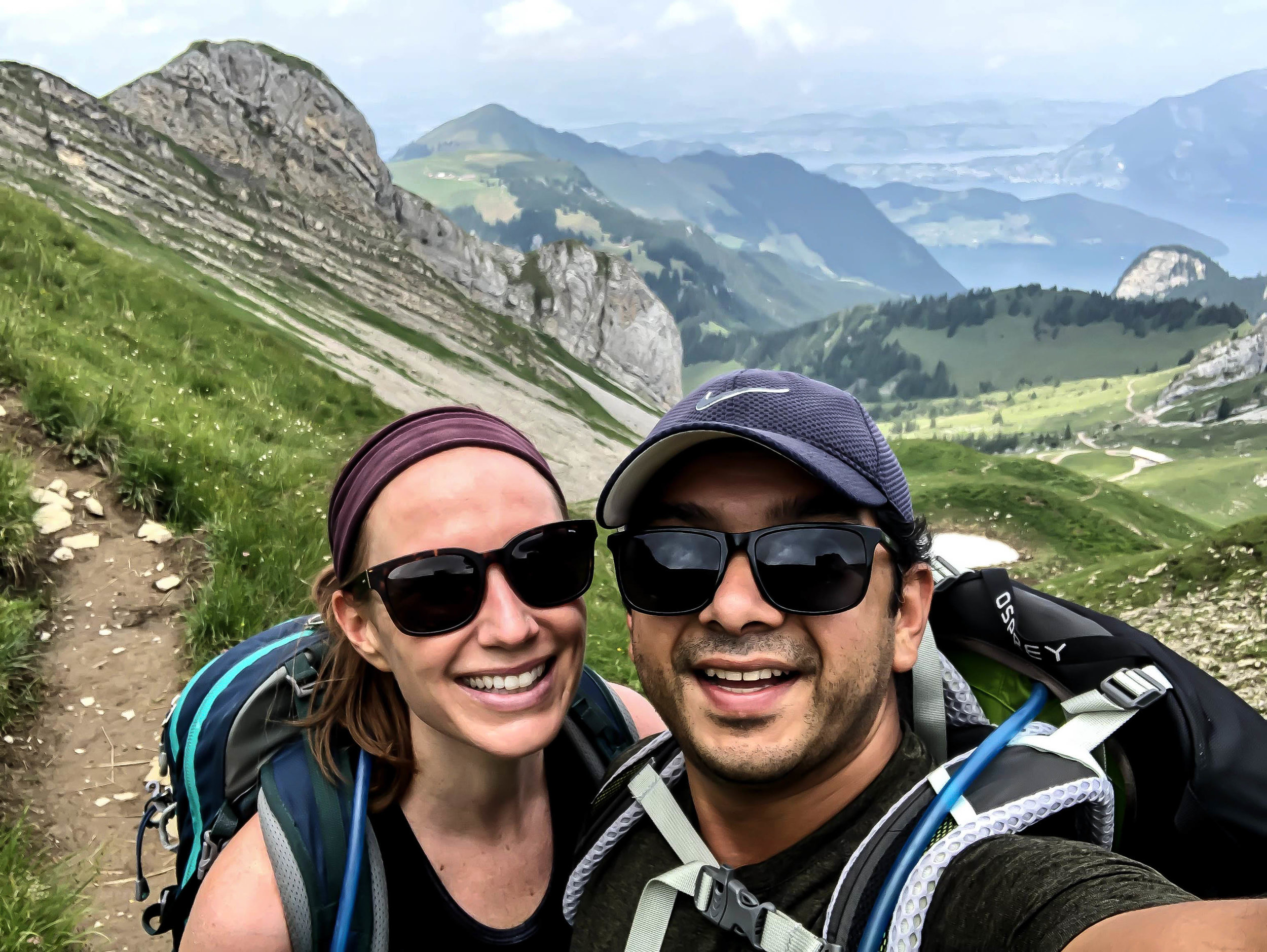
This first ascent was gentle enough, through alpine pastures and small farms. I love this part of Swiss hikes. The idea of a simple, pastoral way of life makes me feel cozy and grounded. I’m sure I’m completely romanticizing the life of a dairy farmer, but it’s a nice thought nonetheless. The cows just look so content, grazing and lazily flicking away flies, enjoying the best views in the world. Well, the dairy cows anyway. You probably wouldn’t want to be a male cow in Switzerland.
The gentle ascent was short-lived, though. Quickly enough, that gradual incline increased in intensity. Once thing you’ll realize in Switzerland is that the ascents are steeeeep. More often than not, as Raunaq and I are huffing and puffing and trudging our way up paths that feel impossibly vertical, we are bristling, “Has this country ever heard of switchbacks?!” To be fair, it’s the most efficient way to get up a mountain: straight up. The first ridgelines started to come into view, as we sweated our way to the Brisenhaus mountain hut. It had only been an hour, but Brisenhaus made a nice spot to eat lunch and rest up a bit before the next push.
The next stage was tougher. Not nearly a scramble, but it was demanding on the legs to climb up through the boulder fields. MomsTots had talked about the “steep descent” in this area of the hike on her blog, and we kept on asking ourselves, “Is this it? It’s this it? Is this what she was talking about?” It was. Tough as it was, I was very happy to be going up instead of down. High above, silhouetted against the gray sky, we could start to see the shapes of hikers along the ridgeline. I felt a surge of excitement. This was going to be epic.
With the boulder fields behind us and Brisenhaus far below, looking like a tiny toy house, we took a moment to drink in the view at Steinalper Jochi. The rain had stayed away but it was still cloudy, casting dramatic shadows onto the valley below. Wildflowers were still in full bloom, delicate blue and purple and yellow buds lining the sides of the trail.
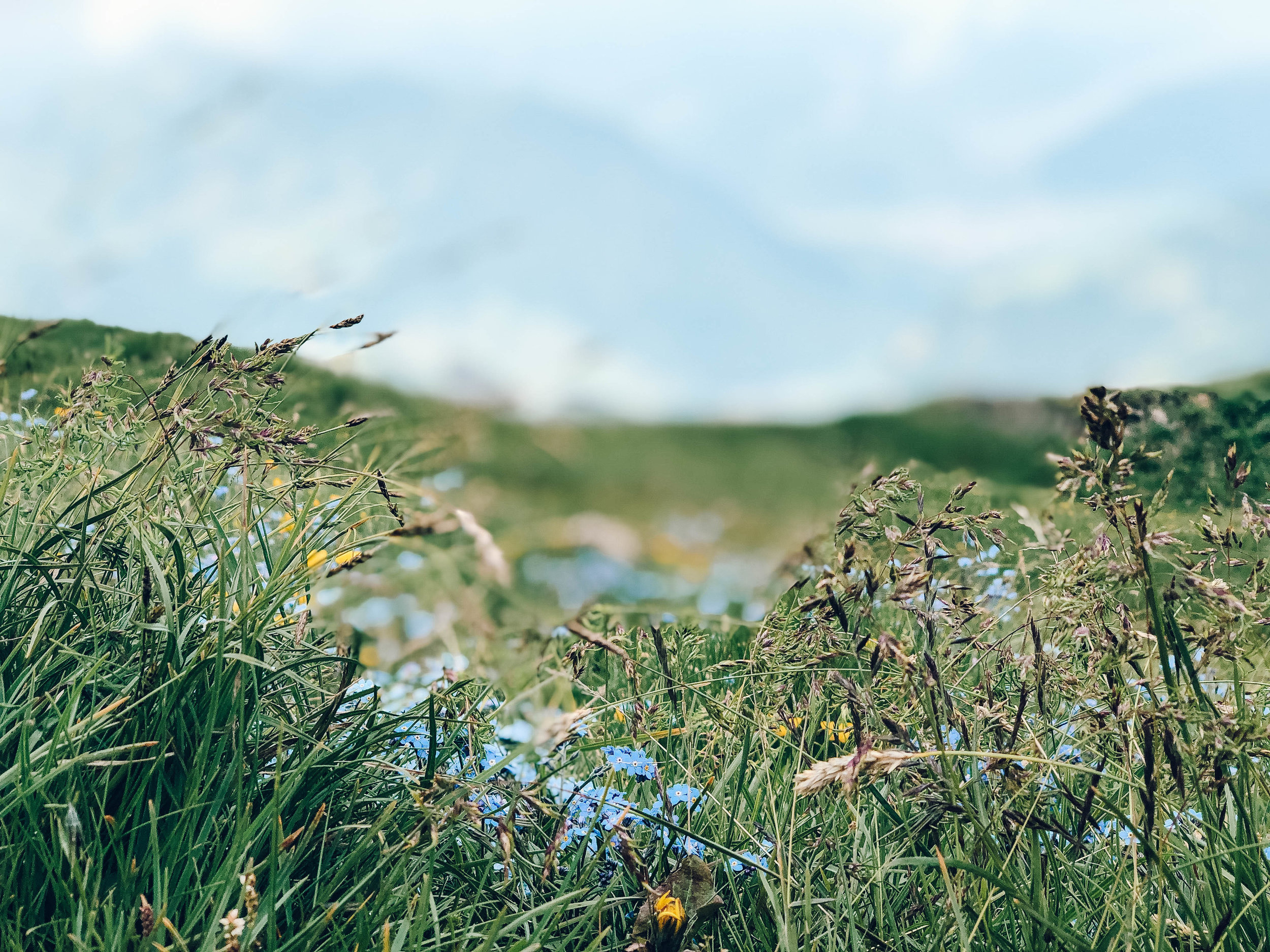
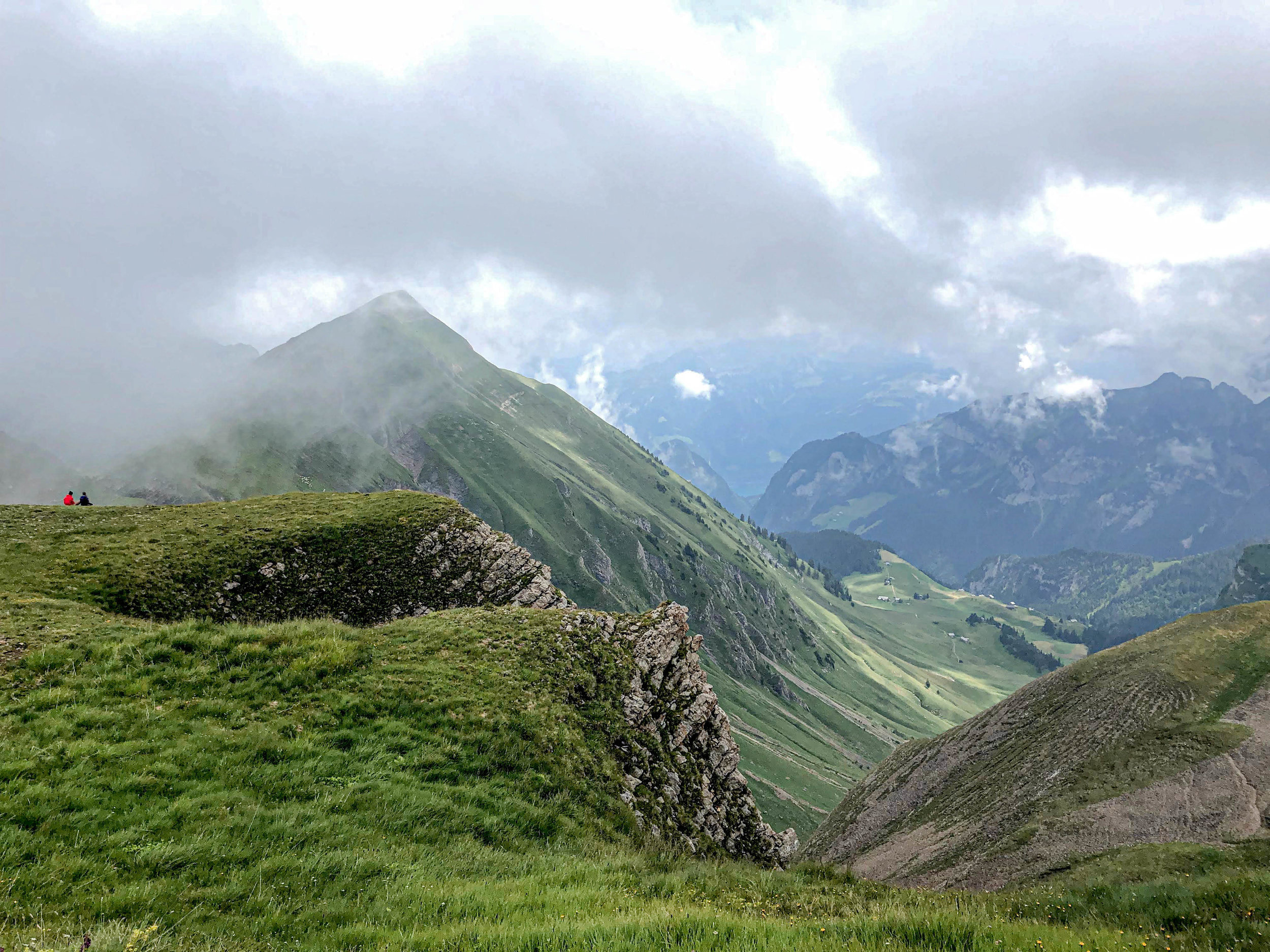
We turned a corner, and then the path transformed into nothing more than a narrow ribbon on a steep stony hillside, passing around the northern side of a large wedge-shaped outcrop. For the first time, suddenly, the Brisen loomed in front of me. “That might be it - but that can’t be it.” It looked terrifying; a towering pyramid of rock, vertical on all sides as far as I could see, the top just barely obscured by wispy fog. There’s no way that there can be a "normal" path up there, I thought. And yet, even from this distance, I could see a few bodies making their way up the peak. Oh god, that’s it. The first inkling of nerves appeared.
Part 2 - Go above your nerve
Steinalper Jochi - Brisen Peak - Zickzackweg - Haldigrat
The path dropped down a bit into a stony pass right below the Brisen’s high rocky walls. I saw the snow field from a distance - a huge, icy swath smack in the vast, rocky scree. Given that the trail we were on was not a wide, comfortable one by any measure, the addition of slushy, slippery snow was decidedly not welcome. We stopped at the start of the snow to consider our options. It would be possible to go around, though that would entail a scramble up and down loose rocks and scree. Not fun. There seemed to be a well-trodden path through the snow field, and we knew that others on the trail before us had taken it, so although it looked a bit sketchy, we decided to forge through.
Late summer snow is unpredictable. It can be icy or slushy, but no matter what, it’s going to be hard to get secure footing without the help of crampons. Even though there was a distinguishable path, it was only wide enough for one foot at a time. It felt like walking on the world’s slickest tightrope. With every step, I had to wedge and twist my heel to secure it into the snow before I felt confident enough to pick up my other foot to move forward. Halfway through, the path got even narrower and steeper. My muscles were shaking from the tension and adrenaline. I felt myself freezing up.
More than anything I wanted to turn around, but it was impossible at that point. There was no way to backtrack. I wanted to disappear. I wanted to cry. I kept telling myself that if I fell, I probably would only break something, I probably wouldn’t die. But there was literally nothing I could do, but take another step forward. And another, and another. Using the top slope of snow to steady myself, I finally made it through. My whole entire body exhaled. It had felt like an eternity, but probably was a total of 10 minutes.
Jumping to quickly present-day: OK. It wasn’t that bad. But I was really - unexpectedly - scared. And here is a reminder that while I am a huge proponent of challenging yourself, know your limits and be smart. I probably wouldn’t cross something like that again without better equipment.
Post-snow, we wound up through a series of small cliffs, slightly exposed but not difficult, then started an even steeper climb to reach a saddle on the ridge. I figured that this must finally be the top, and mustered my energy to power through the last few meters. And then - white. Ha. Nothing like nearly meeting your demise on a path of dirty devil snow, and then finding a wall of fog where a spectacular mountain range should be. It was striking nonetheless. When you are up that high of an altitude, trembling with effort, surrounded by fog, it feels a bit like you are inside of the cloud itself. The wind and the cold and the fog materializing and dissipating added to the wild, remote ambiance.
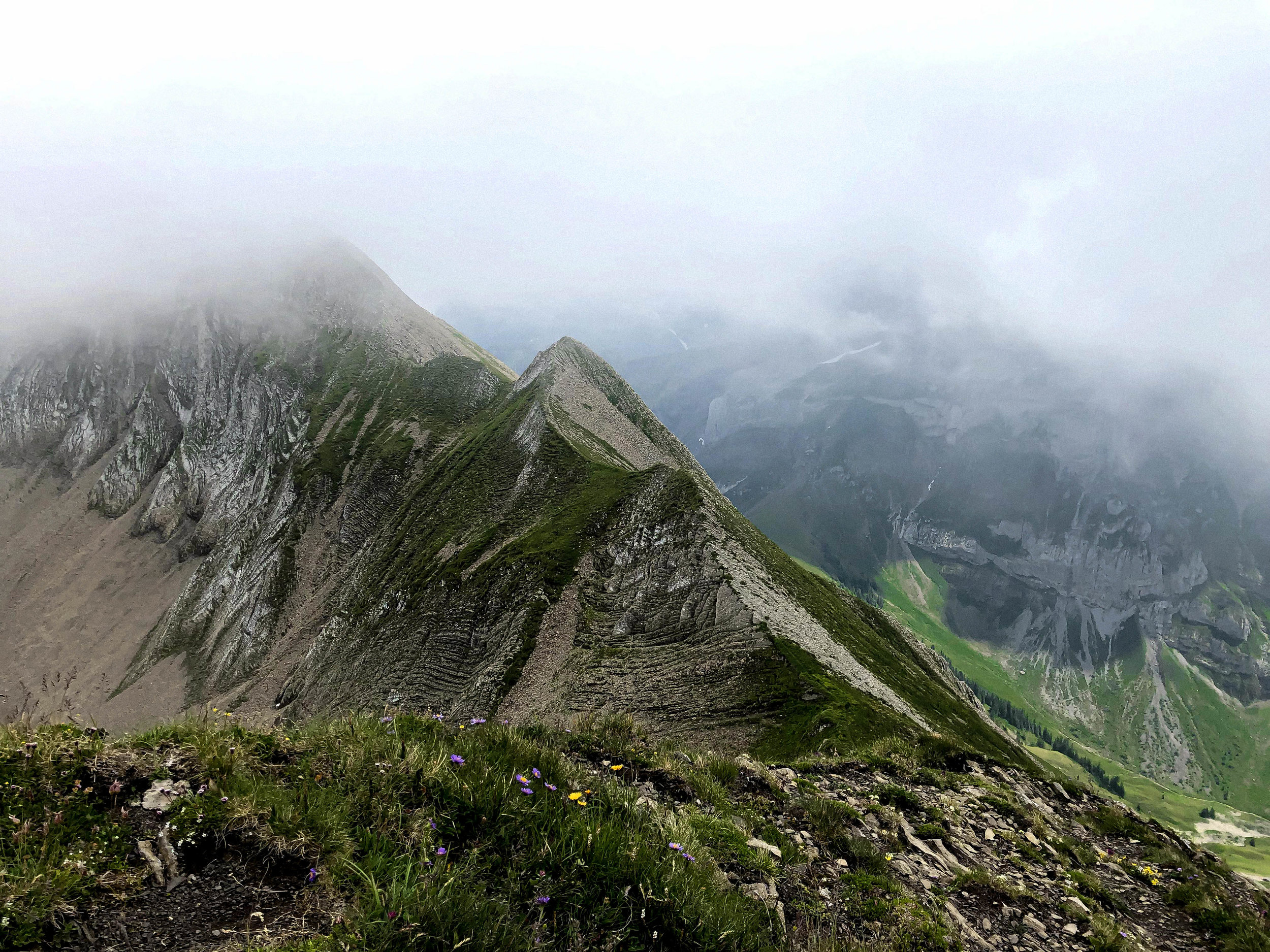
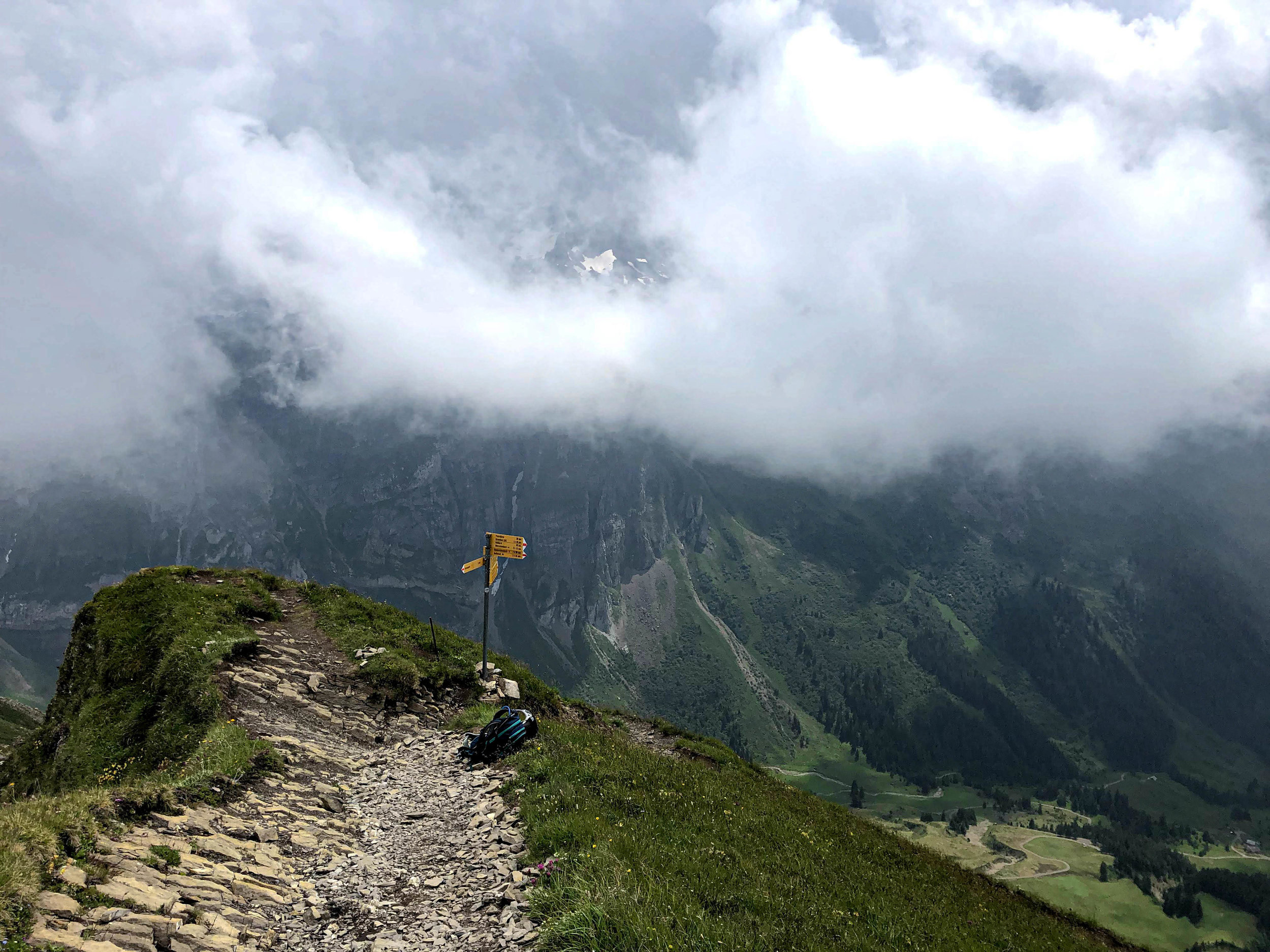
But alas, it was not the top. We were at the saddle that links the Brisen to its slightly higher neighbor, the Hoh Brisen. The yellow wanderweg sign pointing directly up a wall of rocks indicated “Brisen Peak, 5 minutes.” I stared at that sign, shook my head, then took off my backpack, defeated. Just 5 more minutes to go - and I couldn’t move. We were up at the edge of the world, the valley floor spilling out below, and it all felt like too much. Nerves were rattling around in my head like loose marbles. The adrenaline caught up with me and I just sat there for a moment, the wind whipping all around me, head in my hands.
In moments like this, I am so grateful for my yoga practice. I was able to calm down my breathing, recognizing the intense sensations I was feeling and separating the fear from reality. Raunaq decided he was going for the final push to the top. More than anything I just wanted to stay and wait for him, but also, knew I would be so frustrated with myself if I gave up so close to peak. I needed that time to sit, to breath, and to gather myself - and then, I needed to cast aside those mental limitations. Mind over matter, yes, but sometimes it’s mind over mind, too.
The last few meters to the summit were steep, but with clear enough footing, although I was forcing myself not to look at the precipitous drops to the right. I’m almost grateful for the fog. Once we got to the tiny plateau at the top, it was impossible to see anything besides the small metal cross perched on the edge of the north face. I signed the book, proudly, with a “Si se puede!” next to our names for good measure.
And then, for the final challenge. Our planned route would take us along the crest of the Haldigrat, the Brisen's long west ridge. The Haldigrat is described as narrow, airy and exposed, and from the summit it looked particularly frightening. And while being in a narrow ridge was the last place I wanted to go, there was absolutely no way I was going back the way we came. Raunaq and I went slowly and carefully. It’s worth noting here though that Raunaq went slowly and carefully for my sake. As you can see from the photos, he had no problem with these ridges. Exhibit A: Raunaq “surfing” the ridgeline below.
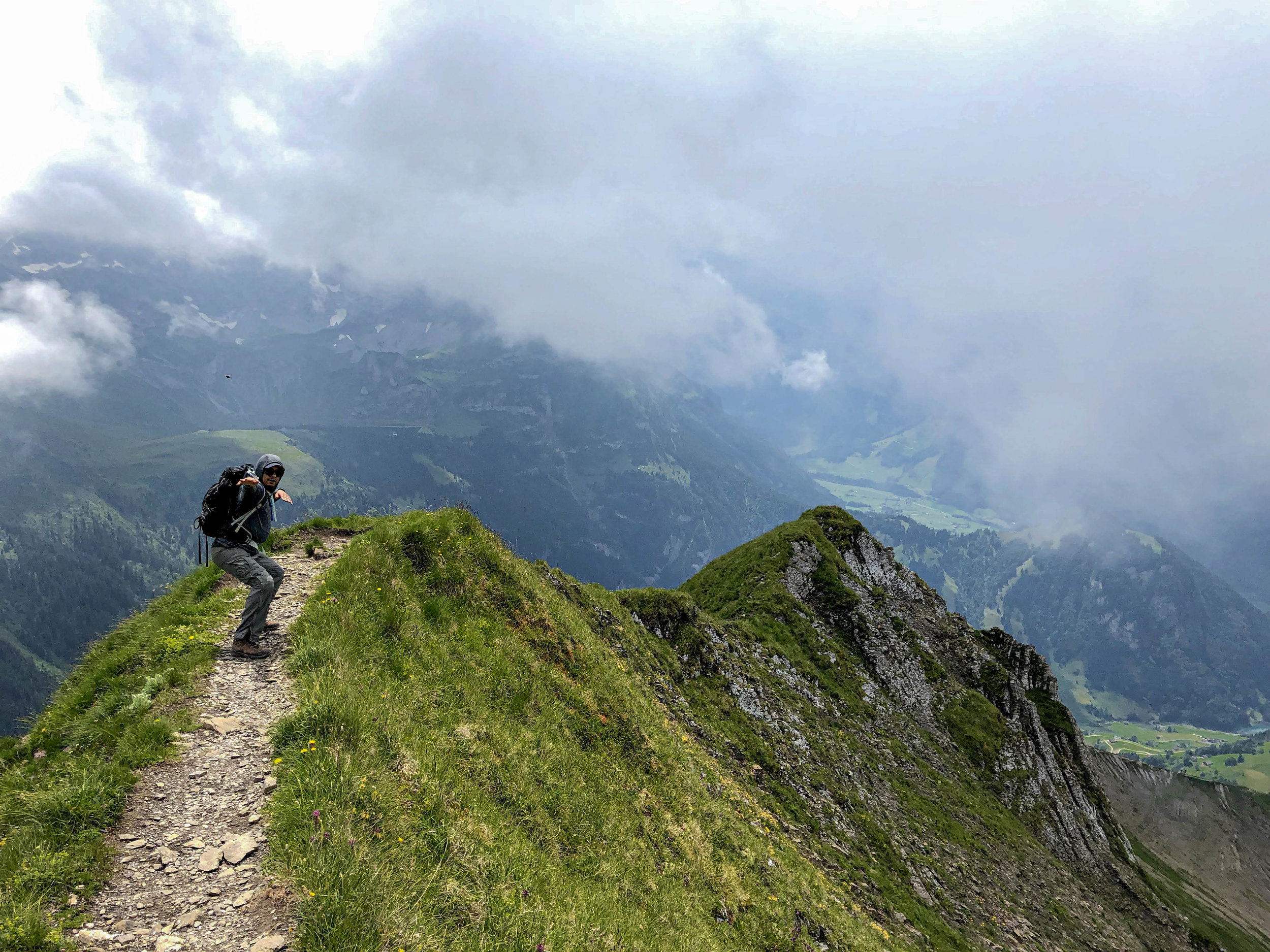
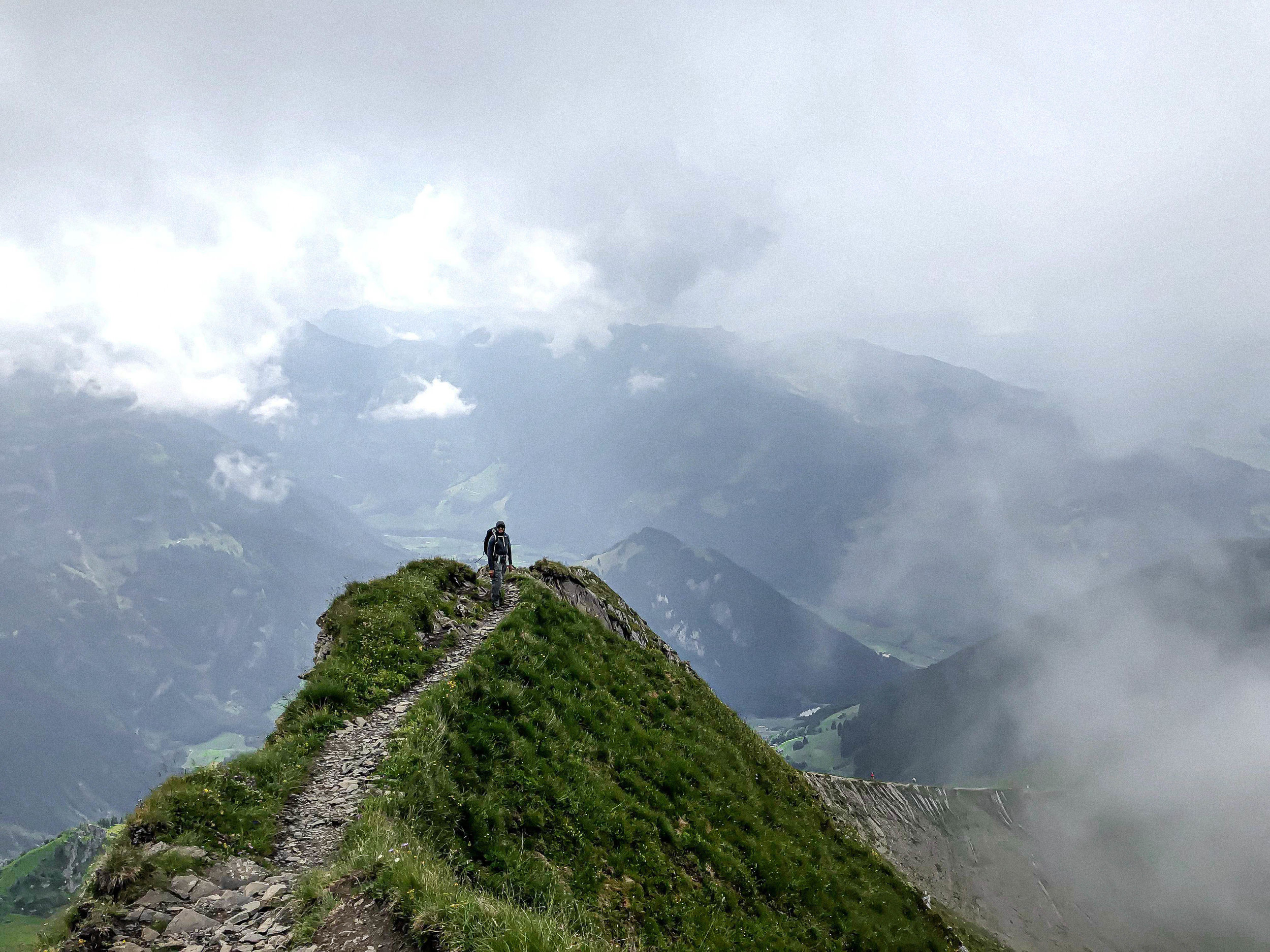
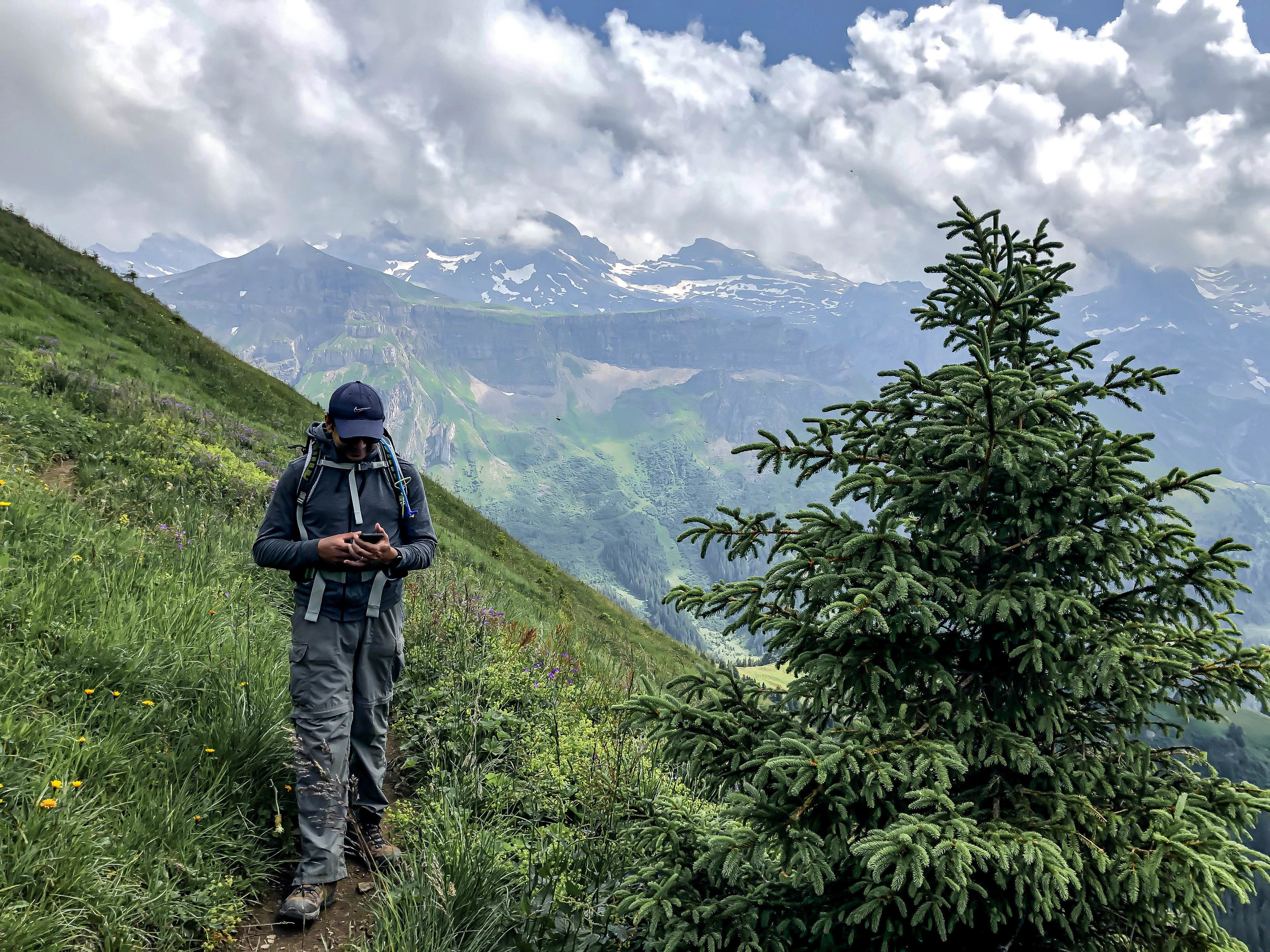
This section should have taken 50 minutes, but it took us nearly two hours. Sometimes the path was along the very crest of the ridge, sometimes just below it on the southern side, narrow but walkable, and always just wide enough for there to be room for feet plus hiking poles. The terrain is certainly exposed – there are any number of places where you would definitely not want to fall over the edge – but you’d really have to try to fall off in calm conditions. When the description say you need a “head for heights,” though, heed them. This is not for those with vertigo.
The worst of the exposure is to the right-hand side, the northern side of the ridge, where the drop is nearly vertical. A couple of times it looked like the ridge was widening out and becoming easier, but every time it became narrower again as it rose up to another secondary summit. And the views. The views were extraordinary. The clouds and fog had finally began to lift, and the sights extended from the Säntis to the Bernese Alps and practically the entire central Swiss Alps region. It was spectacular.
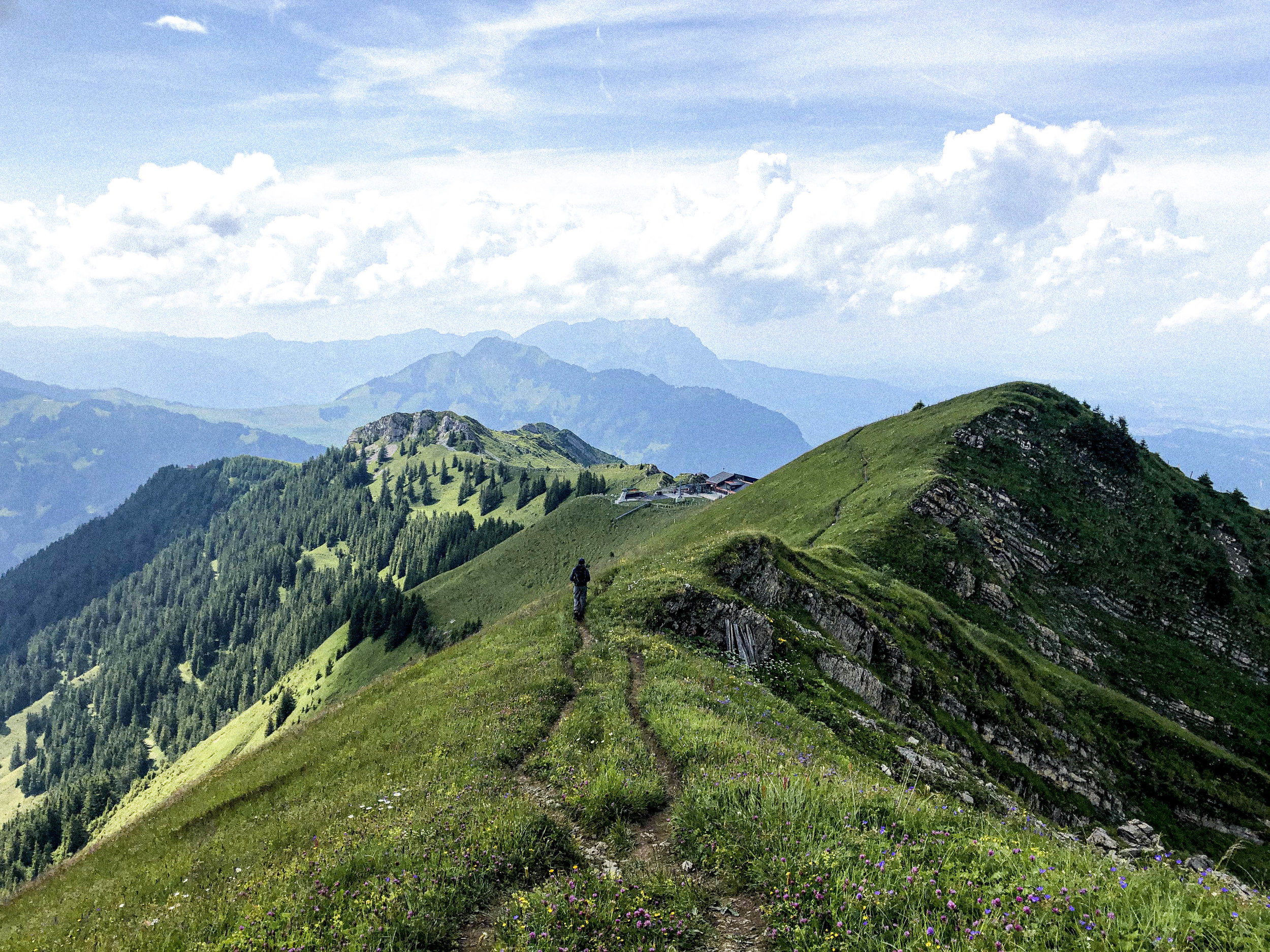
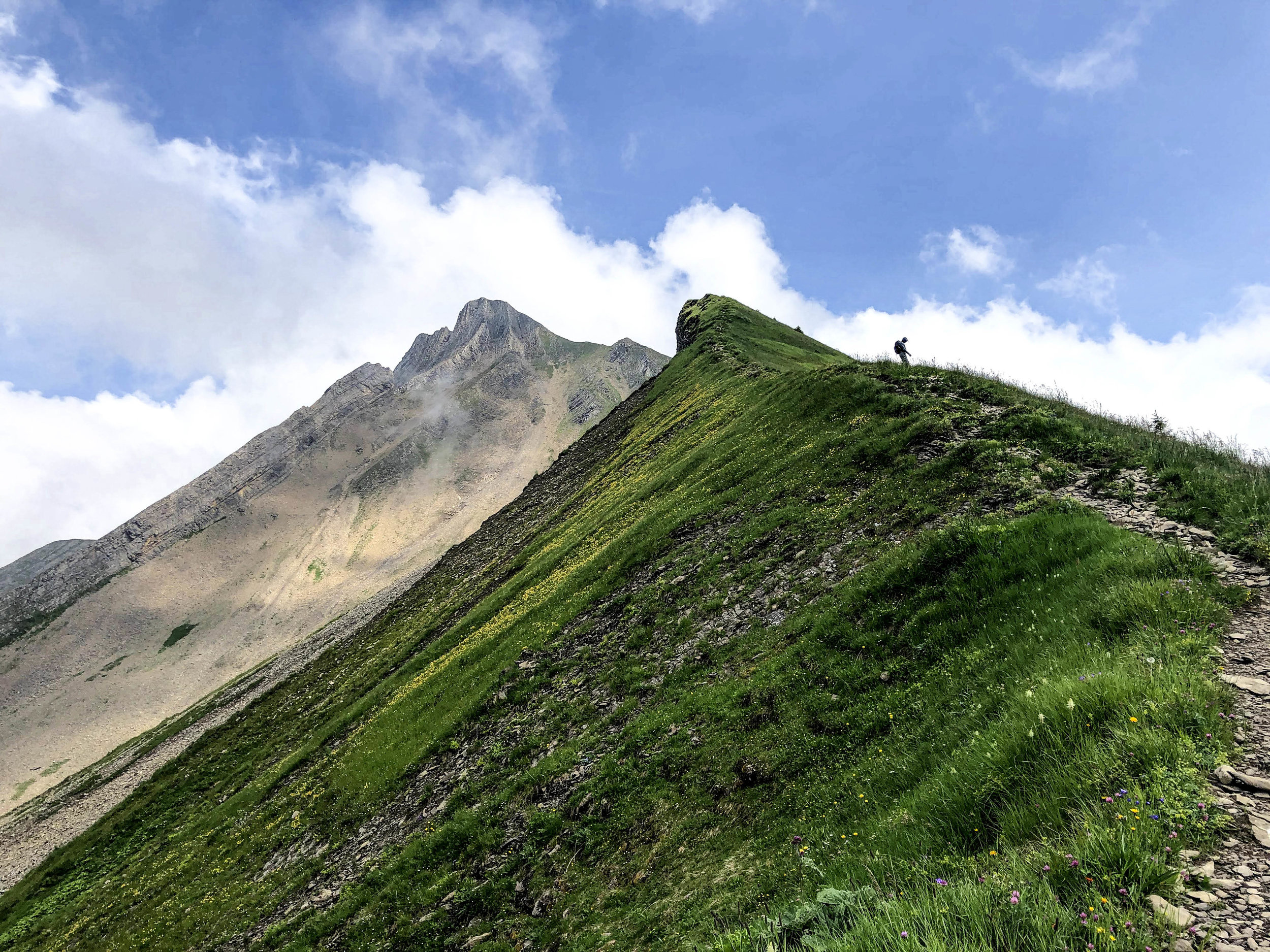
Then, just as suddenly, the excitement was over. The path contours around one last grassy hump, then the ridge broadens out into a plateau, where in true Swiss mountain fashion, there was a restaurant to welcome us back to civilization. It was over. We survived! Never has our post-hike liters of beer felt more deserved. Raunaq and I flopped down into two plastic chairs outside. From the deck, we could see practically the whole days accomplishments: up the long Haldigrat to the summit, then all the way across the valley. It’s impressive. I was giddy and exhausted. Raunaq mentioned that he was surprised that I got so rattled. I was surprised. I rock climb. I’ve climbed a 6,000 meter volcano. I love the adrenaline rush. Normally, I’m much more comfortable in these situations, and for the first time in a long time, I felt out of my element. But it also felt like I had conquered something.
There’s a creaky little chairlift that runs down from the Haldigrat restaurant back down to the Niederrickenbach village that would save us 700 meters of downhill walking. Klaus, the weathered and jaunty lift operator, spoke lots of fast Swiss German and barely any English. I put those A2 intensive German classes to the test, and manage to chat long enough with him to get ourselves a ride back down.
This was one of those “why I hike” trails. It was challenging, and scary, and the views were magnificent and dramatic, and I had to force myself to be completely present and in the moment. Even if some of those moments were simply reminding myself to press on. “Ok, one foot in front of the other, and just don’t look to the sides.” It was just us and the mountain, and the mountain drew out some real emotion. I felt pushed to my edge in a good way, in a way that left me feeling both accomplished and humbled. Raunaq considers it one of the best hikes we’ve done in Switzerland.
I can’t promise you’ll have the same experience I have. Maybe you’ll think this hike seemed like a breeze. Maybe you think I’m crazy. Maybe you’ll think it’s encouraging to see that not everyone has it together all the time, and emotions can manifest themselves in unexpected ways. And hopefully, you’ll be inspired to go tackle a mountain of your own.





